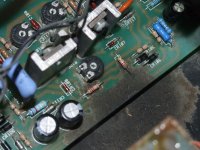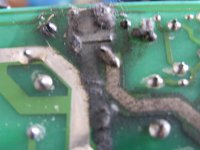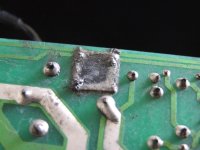hello,
just get ALTEC 9444B, with failure on right channel. Left channel is ok. Clipping light and distortion is audible 🙁
I downloaded manual but I want to know common failures cases for this amp ?
thanks
just get ALTEC 9444B, with failure on right channel. Left channel is ok. Clipping light and distortion is audible 🙁
I downloaded manual but I want to know common failures cases for this amp ?
thanks
YOU downloaded manual .... now upload it here or no cigar.
As of "common failures", same thing.
Everybody wants to hear "oh, a 9444B? easy peasy, R44 always burns, what were they thinking?, just replace it" or similar.
The hard truth is, possible "common faults" are detected and corrected at factory during the design and development process, doubly so in a serious and established Company such as Altec, so to find any fresh problem you´ll have to troubleshoot it, there´s no other way.
So you´ll have to inject signal, scope it at various points, measure voltages, etc.
PS: the proper answer to "common faults" in an old amp is: dry capacitors, dirty/worn pots and connectors, corroded wiring, rusty/corroded connectors, board contacts, dust/lint everywhere, etc.
And in an abused amp: shorted transistors, overheated parts, etc.
All true but generic, not directly pointing at your actual problem.
As of "common failures", same thing.
Everybody wants to hear "oh, a 9444B? easy peasy, R44 always burns, what were they thinking?, just replace it" or similar.
The hard truth is, possible "common faults" are detected and corrected at factory during the design and development process, doubly so in a serious and established Company such as Altec, so to find any fresh problem you´ll have to troubleshoot it, there´s no other way.
So you´ll have to inject signal, scope it at various points, measure voltages, etc.
PS: the proper answer to "common faults" in an old amp is: dry capacitors, dirty/worn pots and connectors, corroded wiring, rusty/corroded connectors, board contacts, dust/lint everywhere, etc.
And in an abused amp: shorted transistors, overheated parts, etc.
All true but generic, not directly pointing at your actual problem.
Last edited:
hi Jim,
agree with you. It was a time where firms had integrated manufacturing lines. "Professionnal" was not only an advertising word.
For amps designed several decades ago, you have usual failures due to intrinsec technology as you pointed (dry capacitors, dirty/worn pots and connectors, corroded wiring, rusty/corroded connectors).
But others problems may appear with aging : resistor cut, composants strain... specific to a model.
I start with repairing and when I get a working system, I will recap it 😉
http://akdatabase.org/AKview/albums/userpics/10007/Altec 9444B Power Amplifier Service Manual.pdf
agree with you. It was a time where firms had integrated manufacturing lines. "Professionnal" was not only an advertising word.
For amps designed several decades ago, you have usual failures due to intrinsec technology as you pointed (dry capacitors, dirty/worn pots and connectors, corroded wiring, rusty/corroded connectors).
But others problems may appear with aging : resistor cut, composants strain... specific to a model.
I start with repairing and when I get a working system, I will recap it 😉
http://akdatabase.org/AKview/albums/userpics/10007/Altec 9444B Power Amplifier Service Manual.pdf
Ok.
Sadly the copy is fuzzy and low contrast and almost unreadable, takes a lot of educated guessing and many times that is not enough.
One particular beef I have with much of the schematics and manuals posted online is that scanners/posters who typically have no clue on Graphics, use the scanner default setting which gives a .jpg output.
Worst format of them all , it was designed on purpose by a group of experts for holiday and kid party pictures color snapshots, not kidding (JPEG comes from Joint Photographic Experts Group) which among other nasty things smears image on purpose to hide pixellation.
Fine for a party/beach picture, horrible for sharp defined black and white lines such as in a schematic.
[rant mode off].

Not wild or crazy by any means, but this big PA amp has some features (very useful there) not present in a regular Hi Fi amplifier
1) which will be very confusing when you measure some voltages or clip your scope probes: in "normal" amps (99.9% of them) , you have fixed +/-V rails and output swings between them. NOT HERE.
In 9444 amplifier mid transistors rail goes to ground, transistor collectors are grounded, so for example measuring continuity from collectors to ground or heat sink WILL show a short, also no micas are used ... most confusing.
2) actual speaker + comes from the centerpoint of big supply caps, what usually is Ground ... not here.
3) rails are not static but follow speaker out signal, a.k.a. "swinging rails" , go figure.
You can measure voltages, signal, everything, but scope/meter ground terminal sometimes goes to unexpected places.
4) start by applying Audio signal at input (J10), it is balanced but with easier to get unbalanced you can use either the + or the - input at J10 and ground the other.
Phone out is NOT enough to drive this amp to clipping or even high levels, I guess it needs 1 or 1.2V RMS (+4dB) , typical of PA amps, while phones provide wimpy 100 to 200mV tops.
You´ll need some kind of preamp, unless you have a Bench-top Generator (not a Phone App).
Scope speaker out paying attention to speaker hot and ground indicated in schematic, and try to drive it into clipping, first without load (voltag out only) and then into a proper 8 or 4 ohm load, any distortion should be visible.
Remember power resistor must dissipate 200W to 500W
200 for short, say 1 minute tests, 400/500 for extended ones.
Ok, setup your bench and show screen captures.
EDIT: amp in itself is an elegant and simple design, very repairable, looks a lot like QSC amps and in fact might have been designed and built for "Altec" under contract.
Which is perfectly fine.
Sadly the copy is fuzzy and low contrast and almost unreadable, takes a lot of educated guessing and many times that is not enough.
One particular beef I have with much of the schematics and manuals posted online is that scanners/posters who typically have no clue on Graphics, use the scanner default setting which gives a .jpg output.
Worst format of them all , it was designed on purpose by a group of experts for holiday and kid party pictures color snapshots, not kidding (JPEG comes from Joint Photographic Experts Group) which among other nasty things smears image on purpose to hide pixellation.
Fine for a party/beach picture, horrible for sharp defined black and white lines such as in a schematic.
[rant mode off].
Not wild or crazy by any means, but this big PA amp has some features (very useful there) not present in a regular Hi Fi amplifier
1) which will be very confusing when you measure some voltages or clip your scope probes: in "normal" amps (99.9% of them) , you have fixed +/-V rails and output swings between them. NOT HERE.
In 9444 amplifier mid transistors rail goes to ground, transistor collectors are grounded, so for example measuring continuity from collectors to ground or heat sink WILL show a short, also no micas are used ... most confusing.
2) actual speaker + comes from the centerpoint of big supply caps, what usually is Ground ... not here.
3) rails are not static but follow speaker out signal, a.k.a. "swinging rails" , go figure.
You can measure voltages, signal, everything, but scope/meter ground terminal sometimes goes to unexpected places.
4) start by applying Audio signal at input (J10), it is balanced but with easier to get unbalanced you can use either the + or the - input at J10 and ground the other.
Phone out is NOT enough to drive this amp to clipping or even high levels, I guess it needs 1 or 1.2V RMS (+4dB) , typical of PA amps, while phones provide wimpy 100 to 200mV tops.
You´ll need some kind of preamp, unless you have a Bench-top Generator (not a Phone App).
Scope speaker out paying attention to speaker hot and ground indicated in schematic, and try to drive it into clipping, first without load (voltag out only) and then into a proper 8 or 4 ohm load, any distortion should be visible.
Remember power resistor must dissipate 200W to 500W
200 for short, say 1 minute tests, 400/500 for extended ones.
Ok, setup your bench and show screen captures.
EDIT: amp in itself is an elegant and simple design, very repairable, looks a lot like QSC amps and in fact might have been designed and built for "Altec" under contract.
Which is perfectly fine.
It is a very elegant and simple solution that very few DIYers use. The sole reason for that is because off the shelf power transformers cannot be used unless it is built with two of them (And that goes to FOUR for a class H version). The power supplies for each channel are required to be independent. Deal breaker for most DIY, but not for OEM. It has the advantage that if one channel is completely dead with blown fuses the other can continue to run. It is also the simplest possible configuration with the lowest part count, which will do the job.
thank you Jim for giving me the key to understand this design. I never saw it before. It seems to adress PA ruggedness needs.
I have an audio generator and 500W loads that I bought for a futur wattmeter, so enough tools 😉
I opened amplifier. and I saw a heavy layer of dust. Even vacum cleaner can't peel off this aggregate. I will borrow air compressor and try again !
thanks for your valuable help
I have an audio generator and 500W loads that I bought for a futur wattmeter, so enough tools 😉
I opened amplifier. and I saw a heavy layer of dust. Even vacum cleaner can't peel off this aggregate. I will borrow air compressor and try again !
thanks for your valuable help
FYI/FWIW, hydrogen peroxide dissolves dust quickly and the active ingredient in fake flower or similar cleaning sprays, so I keep a bottle of it with a fine mist sprayer installed to quickly clean any dusty knickknack/whatever including electronics and of course since the typical bottle is only 3%, so either requires several cleanings + air, soft fine bristle dusting/paint brushing on some baked on dust or buy a higher solution if an option in your locale.
Hose it down after a soak with soapy water.
Let it dry for a day or two.
Use a stiff brush for hard dust.
Been doing that to computer SMPS.
After repair and testing, I coat the foil side with electrical varnish, dust and monsoon moisture always cause trouble, the varnish insulates the PCB from that.
Let it dry for a day or two.
Use a stiff brush for hard dust.
Been doing that to computer SMPS.
After repair and testing, I coat the foil side with electrical varnish, dust and monsoon moisture always cause trouble, the varnish insulates the PCB from that.
hi friends,
Cleaning was a success. I used a solvent and air compressor. This amp was installed near a kitchen of restaurant during 16 years. So dust with grease gave a solid layer :-(
One part pcb seems suspect. I don't know yet if pcb is damaged. I also read that Altec use glue and foam under pcb...
Cleaning was a success. I used a solvent and air compressor. This amp was installed near a kitchen of restaurant during 16 years. So dust with grease gave a solid layer :-(
One part pcb seems suspect. I don't know yet if pcb is damaged. I also read that Altec use glue and foam under pcb...
Attachments
The pcb may not be damaged. It looks like oil stains from the kitchen.
Try squirting some Ronsonol. If it's oil, it'll dissolve.
I don't recall any glue or foam under the pcb.
You can actually remove the entire pcb. Just pull out all the Molex connectors.
With the pcb removed, you can clean the inside of the case as well.
Mike
Try squirting some Ronsonol. If it's oil, it'll dissolve.
I don't recall any glue or foam under the pcb.
You can actually remove the entire pcb. Just pull out all the Molex connectors.
With the pcb removed, you can clean the inside of the case as well.
Mike
That does look like a liquid of some sort got spilled into the amp. If it’s oil/grease it won’t be corrosive, if it’s something else it might. Beer or soda being the worst. I’d pull and clean/replace any components whose leads got contaminated, and physically scrape the substance off the board.
Those rubber pads melted probably due to heat. I doubt that's the cause.
Since the broken channel clip LED is on, it indicates the op amp.
Check the output of the balanced amp and the main voltage amp.
Since the broken channel clip LED is on, it indicates the op amp.
Check the output of the balanced amp and the main voltage amp.
I will follow two steps, 1) reassemble amp and find the problem and 2) update parts for next 10 years !
Pads were not stick on any composant and were fixed on the left/right sides of pcb. So for me, it's not for thermal raison but for spacing. I missed something ?
Pads were not stick on any composant and were fixed on the left/right sides of pcb. So for me, it's not for thermal raison but for spacing. I missed something ?
- Home
- Live Sound
- PA Systems
- Repair 9444B tips ?



